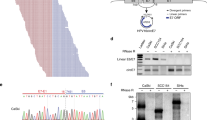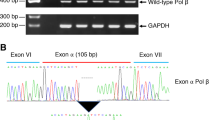Abstract
In a large proportion of familial and sporadic cases of Hirschsprung disease (HSCR) mutations in the RET (rearranged during transfection) protooncogene have been described. We have investigated the structure of the RET gene promoter and have analysed a region of approximately 1000 nucleotides in its promoter and 5′-upstream segments for the occurrence of 5-methyldeoxy-cytidine (5-mC) residues by using the bisulfite protocol of the genomic sequencing method. With an estimated sensitivity of about 93% of this technique, not a single 5-mC residue could be detected in the control region of a gene that seems to be silenced or exhibit low activity in many adult tissues. In these experiments, the DNAs of peripheral white blood cells (PWBC) from four healthy individuals, from seven patients with familial HSCR, as well as DNAs from different human tissues and from a human embryonic kidney (HEK) cell line have been included. In a DNA segment starting 790 nucleotides upstream of the transcriptional start site of the RET gene, a few 5-mC residues have been identified. This region possibly constitutes the transition site from an unmethylated promoter to a more extensively methylated region in the human genome. The data presented are remarkable in that a highly 5′-CG-3′-enriched segment of the human genome with 49 5′-CG-3′ dinucleotide pairs in 400 bp within the putative promoter region is completely devoid of 5-mC residues, although this control region is not actively transcribed in most adult human tissues. By hybridization of a PCR-amplified RET protooncogene cDNA probe harboring exons 9–15 to a membrane (Clontech) containing poly-A selected RNAs from 50 different human tissues, weak RET protooncogene expression in many of the neural cell derived tissues has been detected. RNAs extracted from many other human tissues do not share sequence homologies to this 32P-labeled probe. Mechanisms other than DNA methylation obviously play the crucial role in the inactivation of the RET gene promoter in these tissues. We have also demonstrated by the in vitro premethylation of a RET promoter-chloramphenicol acetyltransferase (CAT) gene construct and transient transfection experiments into neuroblastoma cells that the transcriptional activity of the RET promoter is decreased by HpaII (5′-CCGG-3′) methylation and abolished by SssI (5′-CG-3′) methylation. Hence, the RET promoter region is sensitive to this regulatory signal. However in vivo, DNA methylation of the promoter region seems not to be the predominant regulatory mechanism for the RET protooncogene. Possibly, in adults the RET gene can be occasionally activated.
This is a preview of subscription content, access via your institution
Access options
Subscribe to this journal
Receive 50 print issues and online access
$259.00 per year
only $5.18 per issue
Buy this article
- Purchase on Springer Link
- Instant access to full article PDF
Prices may be subject to local taxes which are calculated during checkout
Similar content being viewed by others
Author information
Authors and Affiliations
Rights and permissions
About this article
Cite this article
Munnes, M., Patrone, G., Schmitz, B. et al. A 5′-CG-3′-rich region in the promoter of the transcriptionally frequently silenced RET protooncogene lacks methylated cytidine residues. Oncogene 17, 2573–2583 (1998). https://doi.org/10.1038/sj.onc.1202165
Received:
Revised:
Accepted:
Published:
Issue Date:
DOI: https://doi.org/10.1038/sj.onc.1202165
Keywords
This article is cited by
-
Genome-wide analysis of DNA methylation in Hirschsprung enteric precursor cells: unraveling the epigenetic landscape of enteric nervous system development
Clinical Epigenetics (2021)
-
On the Biological Significance of DNA Methylation
Biochemistry (Moscow) (2005)
-
The gastrointestinal tract as the portal of entry for foreign macromolecules: fate of DNA and proteins
Molecular Genetics and Genomics (2003)
-
Novel sequence variants of the genes associated with the multiple endocrine neoplasia syndromes 1 and 2. Analysis by an “in silico approach”
Journal of Endocrinological Investigation (2002)



